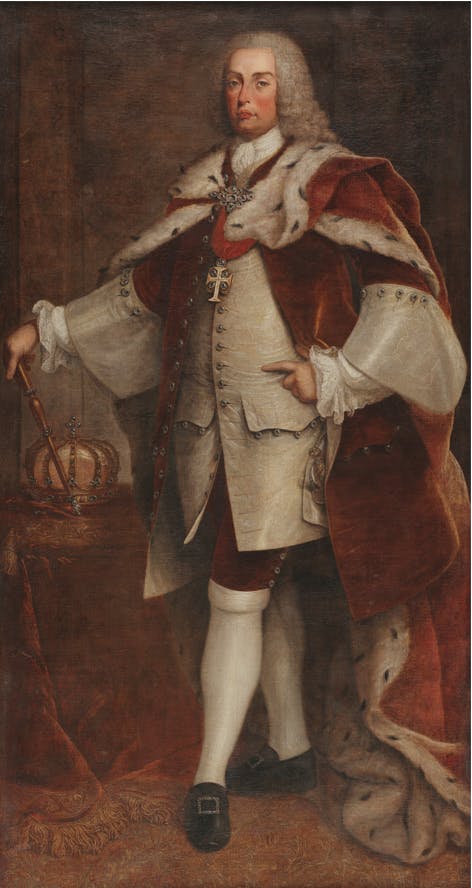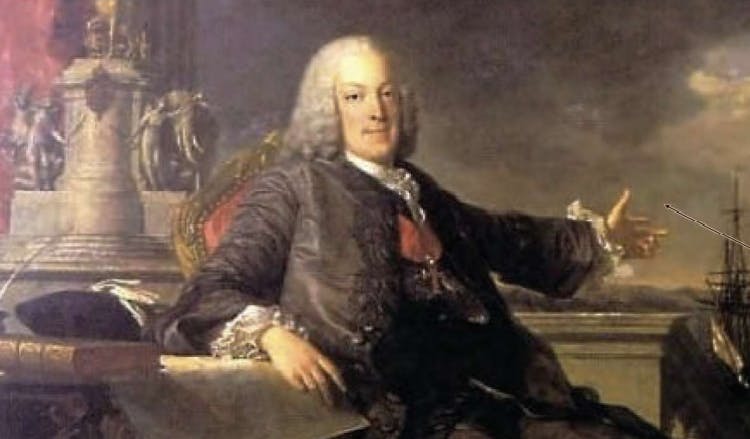On 1 November 1755, the king alone had the power to confirm all decisions after hearing the various councils and courts of the Monarchy. Given the urgency of the situation, it was incumbent upon the secretaries of state to act. But it was not always easy for the secretaries of state to make decisions without the king's approval. Everything depended on the prestige of these secretaries of state, the trust that the king placed in them, and the authority the king gave them. The secretaries of state in place on the day of the earthquake were Pedro da Mota e Silva, secretary of state of the kingdom, Diogo de Mendonça Corte Real, secretary of state for the navy and overseas; and Sebastião José de Carvalho e Melo, secretary of state for foreign affairs and war. The three of them had very different behaviours in the face of the catastrophe. Among the secretaries of state, two did not return to the city. Over seventy years old and ill, Pedro da Mota spent his time behind closed doors in his home. Diogo de Mendonça disappeared for several hours, apparently terrified. He limited himself to sending his Dutch live-in “girlfriend” to bring soups to the queen. Other important court figures, such as António da Costa Freire, a magistrate with experience in diplomacy, and Estevão Pinto, fled to their lands.
According to various accounts, Sebastião José de Carvalho e Melo left his family in his palace and, crossing the city in complete chaos, went to find the king in Belém. Sebastião José, secretary of state for foreign affairs and war, took charge of the situation, making decisions, and frantically signing notices, orders, and provisions addressed to the kingdom's authorities without worrying about the usual formalism or legal rules. He overstepped the boundaries of his mission, which was to deal with diplomacy and war issues because the earthquake was, in fact, an actual “war situation”. The city would not have been in a worse state if the artillery of a terrible enemy had bombarded it. Sebastião José did not waste any time.
When Pedro da Mota died a few days after the earthquake, his papers and all his documents were given to Sebastião José by order of the king. Although Diogo de Mendonça Corte Real apparently supported António Freire de Andrade—one of the supreme court of justice and treasury advisors—to succeed Pedro da Mota, the king was not convinced. Sebastião José showed unrivaled action, and the king, undecided whether to go to Alentejo or stay in Belém, seemed to rely on the political courage of his secretary of state. Of course, the detailed history of the arrangements made makes it possible to identify many other protagonists. Many aristocrats set up field hospitals in gardens with doctors and surgeons. The Duke of Lafões’ brother searched the ruins for dead and wounded, and Monsignor Sampaio, the prelate of the patriarchal church, took charge of burying more than 240 bodies and rescued many people from the ruins. However, nothing seems to compare to the administrative climb performed by Sebastião José.
It was so striking that on 25 February 1756, the “Letter written from Portugal to a Great Spaniard " appeared, accusing Sebastião José of dubious social origin and of having appropriated state revenues. He was described as a “haughty, proud, pretentious, and very weak politician because of his poor origins”. A text by António Pereira, dedicated to the Duke of Lafões, Dom Pedro de Bragança, was also published, praising those who had distinguished themselves the most in the aftermath of the earthquake, completely ignoring the name of Sebastião José. The Duke of Lafões, the Duke of Aveiro, the Marquis of Angeja, the Count of São Lourenço, and the son of the Marquis of Marialva were all highly praised. Likewise, the Marquis of Alorna, Dom Miguel de Almeida Portugal, intendant of finances, viceroy of the Indies before returning in 1752, was associated with Sebastião de Carvalho e Melo’s “opposition”. He was the author of the phrase: “Bury the dead, take care of the living, and close the ports,” was the answer given to the king when he was in a panic about what to do. Alorna died in 1756, but he played an essential role in the wheat collection to feed the city, a mission in which the Marquis of Tancos also participated. However, the memory of his role in response to the earthquake has almost disappeared. This is a sign of the underground struggles that the leading figures of the court were engaged in.
As proof of the seriousness of the situation, on 17 August 1756, a decree offered a reward to anyone who would give information against the plot against Secretary of State Sebastião José, offering 20,000 cruzados to anyone who would provide information about the perpetrators’ identity. António da Costa Freire, a counselor at the supreme court of justice, was considered the leader of the plot to seize power, with the help of the Dukes of Lafões and Aveiro, the Marquises of Angeja and Marialva, the Count of S. Lourenço, some of the most important aristocrats of the kingdom, and a businessman, Martinho Velho da Rocha Oldenburg, representing the interests of trade with the East. Although the accusations were never confirmed, Diogo de Mendonça Corte Real seems to have supported this opposition, undermining the influence of Sebastião José. For their part, the Marquis of Tancos and José Seabra da Silva supported Secretary of State Sebastião José.
Political tension, gradually turning into hate, was part of court society and the type of government in Portugal since the 16th century. It does not seem to have had a hindering effect on the response to the earthquake in the first few months. The leading political figures of the court took on different roles, increasingly entangled in the political web and overtaken by the administrative agility of Secretary of State Sebastião José de Carvalho e Melo.

1 - Sebastião José de Carvalho e Melo (later known as Marquês de Pombal) (1699 - 1782) Secretário de Estado dos Negócios Estrangeiros e da Guerra (Secretary of State for Foreign Affairs and War)
Taking advantage of the absence of the two other government secretaries—Pedro da Mota e Silva and Diogo de Mendonça Corte Real—Carvalho e Melo set out to deal with the crisis and worked hard during the days following the earthquake.
Carvalho e Melo, a nobleman of the middle nobility with no known education, was a well-respected diplomat, having served in London and Vienna, and succeeded in the royal court, where he was appointed secretary of foreign affairs and war in 1750. Because e Melo’s home was not destroyed in the catastrophe, the king considered his Secretary to be under divine protection, but some in the court thought this was a ridiculous idea. Much has been speculated about the reasons for the king's trust in Sebastião José, from his Austrian wife's relationship with the widowed queen to the secretary's interest in business in Brazil, which was increasingly important at the court. If it is true that the gold of Minas Gerais in Brazil was seen as the desperate lever for Lisbon’s reconstruction, the secretary's capacity for work and energy was undoubtedly a decisive factor. On the very day of the earthquake and in the following days, Carvalho e Melo made many important decisions in the name of the king, submitting to the king's orders as early as 2 November 1755, the Duke of Lafões and D. Diogo de Noronha, Marquis of Marialva, with the unavoidable words: “His Majesty commands!”. Sebastião José had a wooden hut made from war tents brought from the Alentejo built near the King's Tent. There, he installed his secretariat of state. He mobilised the chain of justice and established order from then on.
On 4 May 1756, King D. José appointed Sebastião José de Carvalho e Melo to the secretariat of state for the kingdom's affairs, formalising his power over the territory, which allowed him to accumulate other secretarial positions to which he would appoint ministers of confidence. Accumulating many important positions, he would later become Conde de Oeiras and afterwards Marquês de Pombal, the name he retained through history.

Bibliography
Luís Ferrand de ALMEIDA, «O absolutismo de D. João V», Páginas Dispersas: Estudos de História Moderna de Portugal, Faculdade de Letras, 1995, pp. 183-201.
Marquês de ALORNA, Memórias Políticas, Tribuna da História, 2008.
J. Lúcio de AZEVEDO, O Marquês de Pombal e a sua época, Clássica Editora, 1990.
Rômulo de CARVALHO, «O Recurso a pessoal estrangeiro no tempo de Pombal», Revista de História das Ideias, Vol. 4, tomo I, 1982, pp. 91-117.
José Sebastião da Silva DIAS, «Pombalismo e projecto político», Cultura, História e Filosofia, 2, 1983, e 3, 1984.
Jorge Borges de MACEDO, A situação económica no tempo de Pombal, Moraes, 1982
Jorge Borges de MACEDO, O Marquês de Pombal (1699-1782), Lisboa, Biblioteca Nacional, 1982.
Charles R. BOXER, «Pombal's Dictatorship and the Great Lisbon Earthquake, 1755», History Today 5, nº 11, 1955, pp. 729–36.
Charles R. BOXER, «Some Contemporary Reactions to the Lisbon Earthquake of 1755», Revista da Faculdade de Letras XXII, no. 1, 1956, pp. 113–29.
José Luís CARDOSO, «Pombal, o Terramoto e a Política de Regulação Económica», O Terramoto de 1755: Impactos históricos, Ana Cristina ARAÚJO, José Luís CARDOSO, Walter ROSSA e Joaquim Veríssimo SERRÃO (organização), Livros Horizonte, 2007, pp. 165-181.
Frei Cláudio da CONCEIÇÃO, Gabinete Historico que a sua magestade fidelissima, o senhor rei D. João VI, em o dia de seus felicissimos annos, 18 de Maio de 1818, Tomo XIV, Impressão Régia, 1820.
Pe. Anselmo ECKART, Memórias de um jesuíta, prisioneiro de Pombal, Livraria A.I., 1987.
Francisco Luiz GOMEZ, Le Marquis de Pombal: Esquisse de sa vie publique, Imprimerie franco-portugaise, 1869.
Luís Gonzaga JAEGER, A expulsão da Companhia de Jesus do Brasil em 1760, Porto Alegre, 1960.
Rui Manuel de Figueiredo MARCOS, As Companhias Pombalinas: Contributo para a História das Sociedades por Acções em Portugal, Almedina, 1997.
Sebastião José de Carvalho e MELO, Escritos econômicos de Londres (1741-1742), Biblioteca Nacional, 1986.
Sebastião José de Carvalho e MELO, O Marquês de Pombal e a Companhia de Jesus: correspondência inédita ao longo de 115 cartas (de 1743 a 1751), António Lopes (organização), Principia, 1999.
Tiago C. P. MIRANDA, «O governo português e a companhia de jesus no quadro da aliança com a Inglaterra: desarranjos e acomodações (1755-1757)», Lusitania Sacra, 2. série, Tomo V, 1993, pp. 251-297.
Nuno Gonçalo MONTEIRO, «Sebastião José e o Terramoto: entre o governo da casas e o governo do reino», O Terramoto de 1755: impactos históricos, Ana Cristina ARAÚJO, José Luís CARDOSO, Walter ROSSA e Joaquim Veríssimo SERRÃO (edição), Livros Horizonte, 2007, pp. 225–36.
Nuno Gonçalo MONTEIRO, D. José: na sombra de Pombal, Temas & Debates, 2008.
Eduardo Freire de OLIVEIRA, Elementos para a história do Município de Lisboa, Tomo XVI, Lisboa, 1909.
Manuel de SALDANHA, conde da Ega, As cartas de Manuel de Saldanha 1° Conde da Ega e 47.° Vice-rei da Índia para Sebastião José de Carvalho e Melo e seus irmãos (1758-1765), Subsídios para a história política, económica e social da Índia portuguesa de setecentos, Gabinete Português de Estudos Humanísticos, 1984.
Visconde de SANTARÉM, Quadro elementar das relações políticas e diplomáticas de Portugal com as diversas potências do mundo desde o princípio da monarchia portugueza até aos nossos dias, Tomo VI, Lisboa, 1850.
Joaquim Veríssimo SERRÃO, O Marquês de Pombal. O homem, o diplomata e o estadista, Câmara Municipal de Lisboa, 1987.
José SUBTIL, «As repercussões políticas do terramoto», Portugal Aflito e Conturbado pello Terramoto do anno de 1755, Inês Morais VIEGAS, Sara LOUREIRO e José SUBTIL (edição), Divisão de Gestão de Arquivos da Câmara Municipal, 2010, pp. 241-284.